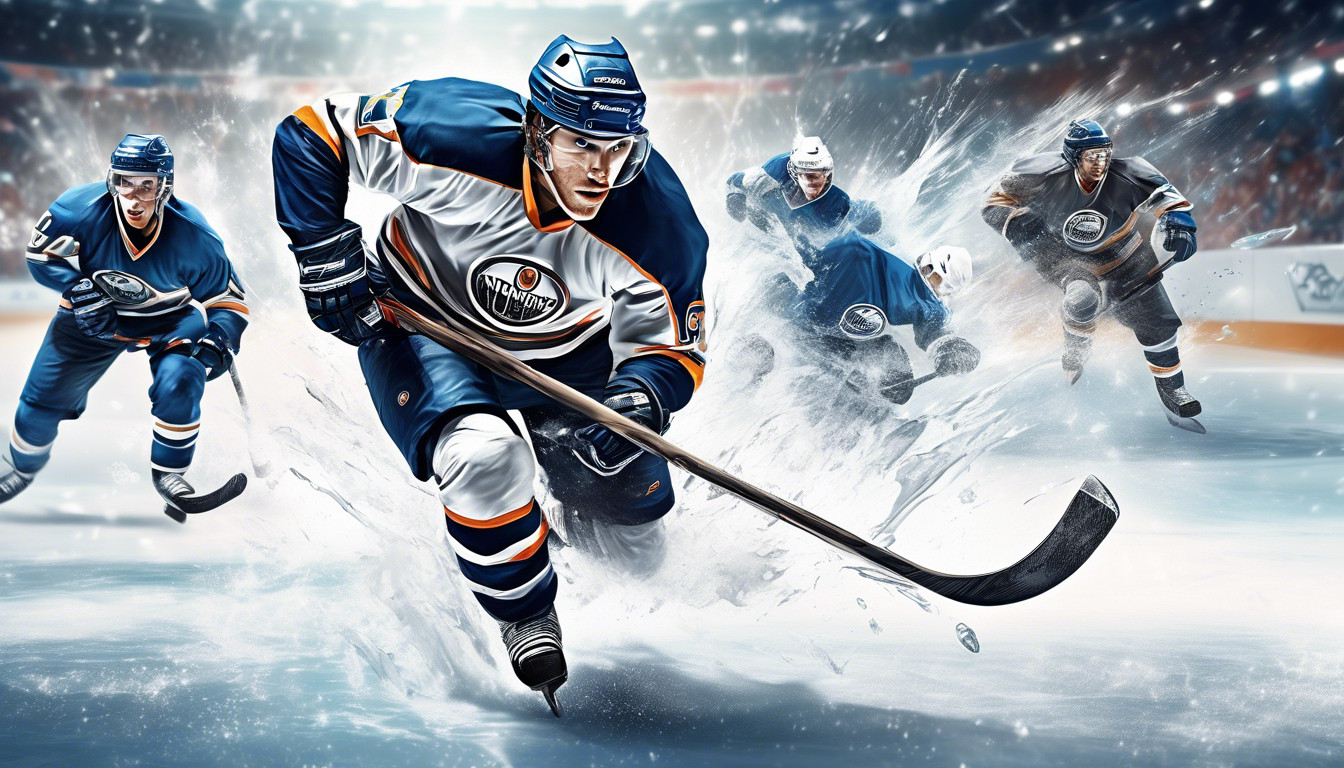In the evolving world of hockey, we find ourselves immersed in an era where skating skills define the modern player. As enthusiasts and players alike, we recognize that the game has transcended its traditional boundaries, demanding a new level of agility, speed, and precision. These attributes are not just desirable; they are essential.
Together, we witness how today’s hockey athletes glide across the ice with a finesse that speaks to rigorous training and an unwavering commitment to excellence. Our collective understanding has grown to appreciate that skating is not merely about forward motion but encompasses a spectrum of skills, including:
- Explosive starts
- Tight turns
- Swift transitions
As we delve into the intricacies of these skating techniques, we aim to uncover how they set apart the good from the great. These skills shape the very fabric of contemporary hockey and inspire the next generation of players to push the limits even further.
Efficient stride mechanics
Mastering efficient stride mechanics is crucial for modern hockey players aiming to enhance their speed and agility on the ice. Being part of a team means pushing each other to become the best we can be, and understanding our stride mechanics is a big step toward that goal.
Key aspects of stride mechanics:
- Strides need to be powerful and controlled, allowing smooth transitions between sprints and turns.
- Focus on maintaining proper edge control, ensuring blades grip the ice correctly for stability and balance during intense games.
Incorporating agility drills into our training helps refine these mechanics. Through drills, we practice:
- Quick direction changes
- Improved overall responsiveness
We can feel the difference when our movements become more fluid and natural. Together, as we work on these skills, we create a shared sense of accomplishment and belonging, knowing we’re all contributing to our team’s success on the ice.
Crossovers for speed
Crossovers are essential for boosting our speed and maneuverability on the ice. They allow us to maintain momentum and change directions swiftly, giving us an edge in the game.
When we execute crossovers, stride mechanics come into play. It’s all about using the correct technique to generate power without losing balance. By focusing on:
- Pushing off the inside edge of one skate
- Pushing off the outside edge of the other
we maximize our stride efficiency.
Edge control is crucial, too. We need to feel confident shifting our weight from one edge to the other smoothly. This requires practice and dedication, but mastering it ensures we can react quickly and effectively during a match.
Incorporating agility drills into our training routine helps refine these skills. Through drills, we can:
- Simulate game situations
- Improve our reaction times
- Enhance overall performance
Together, these elements form the foundation of our crossover technique, connecting us as a team on the ice.

Backward skating proficiency
Backward skating is a vital skill in hockey that enhances defensive abilities and maintains control while surveying the rink. Mastering this skill allows players to:
- Keep their eyes on the play
- Anticipate opponents’ moves
- Stay connected with teammates
Stride mechanics are essential for backward skating. This involves:
- Pushing off with power
- Gliding efficiently using edges
Edge control is crucial for:
- Making tight turns
- Performing sudden stops without losing balance
This requires players to feel the ice beneath their skates and make necessary adjustments to stay ready for any challenge.
Agility drills are significant in honing these skills. Through repetition, players develop the quickness and precision required to respond to fast-paced game situations.
Teamwork plays a key role, as players push each other to improve. The collective strength of a team lies in each individual’s dedication to mastering these essential skills.
With proficiency in backward skating, players can confidently face any opponent.

Edge control mastery
Mastering edge control empowers us to execute swift maneuvers and maintain stability under pressure. As a team, we recognize that edge control isn’t just a skill; it’s the foundation of our skating prowess.
By refining our stride mechanics, we enhance our ability to:
- Cut sharply
- Change directions quickly
- Outmaneuver our opponents
We all strive to improve, and edge control is where it starts. Through dedicated agility drills, we train our bodies to react instinctively, building the muscle memory needed to skate with precision.
When we hit the ice, we’re not just skating; we’re connecting with each other through shared effort and commitment. Every practice, we push ourselves and support our teammates in mastering these essential skills.
Our collective improvement strengthens our bond, making us a formidable force on the ice. By focusing on edge control, we ensure we’re always a step ahead, ready to face any challenge and seize every opportunity that comes our way.

Pivoting techniques
Pivoting techniques are crucial for modern hockey players, enabling swift changes in direction and maintaining momentum during intense gameplay. By mastering these techniques, players become more effective on the ice, enhancing team dynamics and creating a sense of unity.
Stride mechanics play a vital role in pivoting, as they allow players to transition smoothly between forward and backward skating. The focus is on maintaining fluid movements while adjusting the stride to stay in control.
Edge control is another key component. It ensures players can lean into turns confidently without losing balance, allowing them to navigate tight spaces and outmaneuver opponents.
To refine these skills, players regularly practice agility drills, which enhance their ability to pivot quickly and efficiently. Some of these drills include:
- Cone weaves
- Figure eights
These drills help improve reaction times and adaptability.
Together, these elements contribute to a player’s agility, making them formidable on the ice and fostering a strong sense of camaraderie among teammates.

Balance and stability drills
Developing balance and stability drills is essential for hockey players to maintain control and execute maneuvers effectively during high-speed play. As a team focused on growth, we understand that honing stride mechanics is crucial.
By practicing these drills, we ensure each stride is powerful and efficient, enhancing our overall performance on the ice. Together, we work on mastering edge control, which is key in maintaining our balance while navigating tight turns and sudden stops. This skill allows us to glide smoothly and confidently, turning potential chaos into calculated plays.
Incorporating agility drills into our routine further refines our stability. These exercises challenge us to stay grounded and composed, even when the game gets intense.
Sharing these experiences and pushing our limits brings us closer, creating a sense of unity and trust. As we improve, we become a formidable force, ready to face any opponent with determination and skill.
Let’s keep striving for excellence together!

Quick feet agility drills
Quick Feet Agility Drills
Quick feet agility drills are essential for enhancing our speed and responsiveness on the ice. By honing our stride mechanics and improving our edge control, we can make quick decisions and change directions seamlessly. These drills help us stay sharp, ready to adapt to the fast-paced nature of hockey. In our community, where teamwork and unity matter, mastering these skills is our collective goal.
Focus During Practice
When we practice agility drills, we focus on quick, controlled movements that refine our balance and coordination.
Some exercises include:
- Zigzag sprints
- Ladder drills
- Cone weaves
These exercises push us to optimize stride mechanics and edge control. This not only boosts our individual performance but strengthens our bond as a team, knowing that each of us is dedicated to improving.
Building a Shared Identity
Together, we encourage one another, celebrating the small victories on the ice. By committing to these drills, we’re not just honing our physical abilities; we’re building a shared identity of skilled, agile hockey players.

Acceleration bursts
Acceleration Bursts
Acceleration bursts are crucial for gaining an edge over opponents and quickly closing the gap on the ice. The speed of a game can change in an instant, and that’s where mastering our stride mechanics comes into play.
By focusing on efficient strides, we:
- Maximize power
- Minimize wasted energy
- Accelerate faster
- Maintain top speed longer
Edge Control
Edge control is another key element. Mastering our edges allows us to:
- Push off with more force
- Change direction seamlessly
This not only boosts our acceleration but also enhances our overall agility on the ice.
To achieve this, we must incorporate agility drills into our training routine. These drills help us:
- Build muscle memory
- Refine skills needed for quick bursts of speed
Team Impact
Together, these elements create a powerful combination that sets us apart. In a team where everyone belongs and contributes, perfecting acceleration bursts makes us formidable competitors.
Let’s keep pushing each other to reach new heights.

Controlled stops and starts
Mastering controlled stops and starts is vital for maintaining agility and responsiveness during intense gameplay. As a team, we understand that perfecting these skills can make all the difference on the ice.
Stride mechanics need to be sharp, ensuring each movement is efficient and precise. By focusing on proper edge control, we can swiftly transition from high-speed chases to sudden stops, keeping us one step ahead of our opponents.
Agility Drills:
- We often engage in agility drills to hone these skills.
- Practice is repeated until quick changes in direction become second nature.
These drills not only strengthen our physical abilities but also tighten the bonds between us, fostering a sense of unity and trust.
Team Benefits:
- Elevate our game by working together on controlled stops and starts.
- Create a shared sense of purpose and belonging.
- Fuel our passion for hockey by pushing each other to be the best.

Body positioning techniques
Proper body positioning is crucial in enhancing our balance and stability on the ice. As we refine our stride mechanics, we must focus on maintaining a low center of gravity.
- Bending our knees
- Keeping our heads up
These actions allow us to maximize power and speed. It’s not just about moving forward; our edge control plays a significant role in executing sharp turns and quick stops. We need to trust our edges, leaning into them with confidence to maneuver effectively against opponents.
Participating in agility drills helps us sharpen these skills, allowing us to react faster and move with fluidity. By practicing:
- Lateral movements
- Quick pivots
We become more adaptable, ready to respond to any situation. Together, we create a seamless connection between our body positioning and our skating skills.
Embracing these techniques unites us on the ice, making each of us a more formidable player and strengthening our bond as a team. Let’s keep pushing our limits and supporting each other.

Shooting off the rush
Mastering the art of shooting off the rush allows us to capitalize on fast breaks and catch our opponents off guard. It’s a skill that demands we harness our stride mechanics, ensuring each push is powerful and efficient.
- Precise stride mechanics provide the speed needed to break away from defenders.
- Impeccable edge control is essential to navigate swiftly and maintain balance, even when maneuvering through tight spaces or adjusting for a shot.
Incorporating agility drills into our training regimen is crucial. These drills enhance our ability to transition seamlessly from skating to shooting. They ensure that, as a team, we can react quickly and exploit every scoring opportunity.
When we practice shooting off the rush, we strengthen our unity on the ice, becoming a force that’s both unpredictable and relentless. Together, we elevate our game, embracing the exhilaration of executing a perfect shot on the fly.

Defensive skating strategies
To become formidable defenders, we must master skating techniques that allow us to effectively position ourselves against opponents and swiftly intercept their plays.
Our journey begins with refining our stride mechanics, ensuring each movement is efficient and powerful. By focusing on our stride, we create stability and speed, crucial for defensive maneuvers.
Next, we delve into edge control. This skill enables us to glide seamlessly and change directions with precision. When we control our edges, we maintain balance and react quickly, crucial for disrupting the opponent’s flow.
- Practicing tight turns and stops helps us anticipate and counter any offensive threats.
Incorporating agility drills into our training sharpens our reflexes and enhances our ability to maneuver in tight situations. These drills challenge us to think quickly and move decisively, reinforcing our defensive capabilities on the ice.
Together, through dedication and teamwork, we build a solid foundation for our defensive skating strategies, ensuring we stand strong against any offensive pressure.